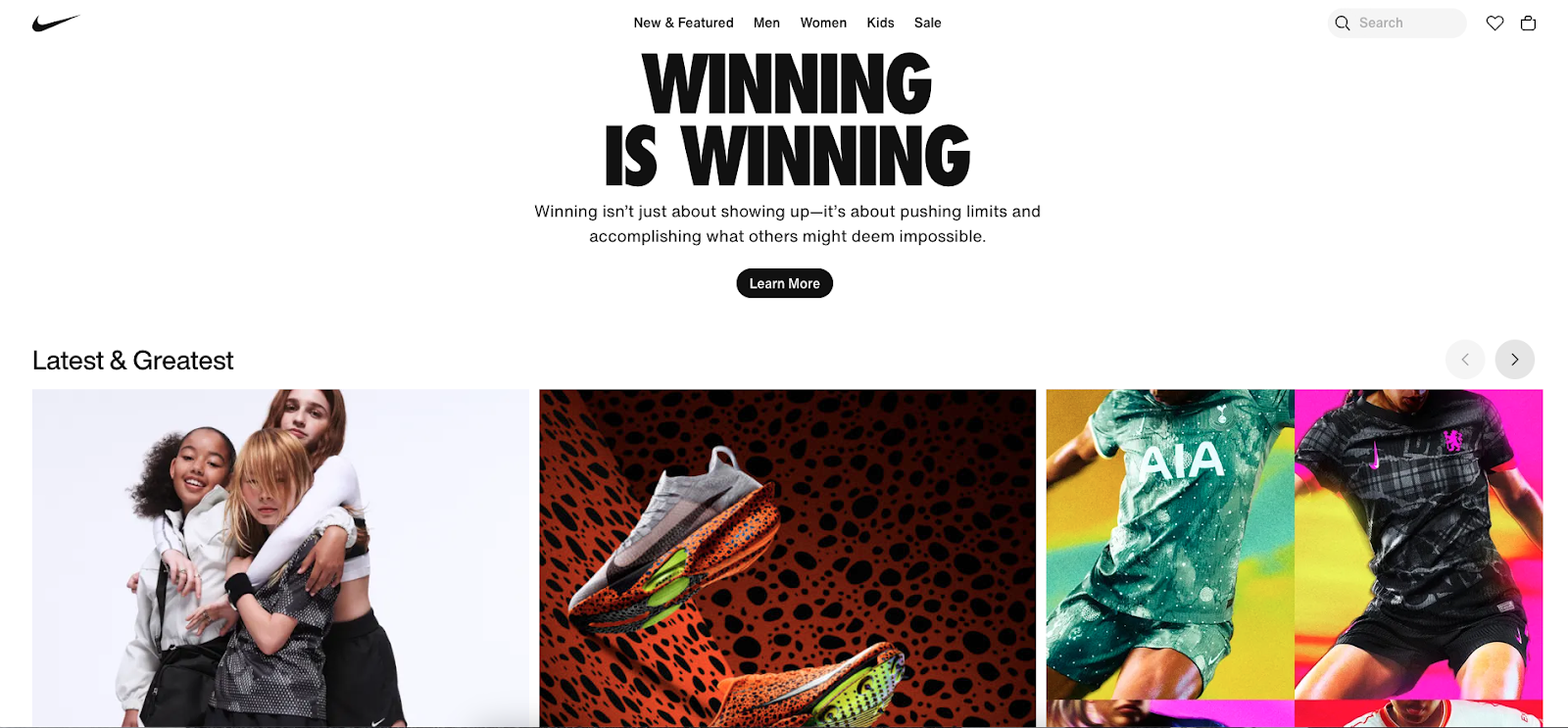A great brand story packs an emotional punch while encouraging audience engagement.
Brand storytelling promotes meaningful associations and connects with your customers on a deeper level by creating a compelling narrative about your brand. A brand story sets you apart in a crowded market where countless companies vie for attention.
Without a compelling narrative, your company might blend into the background, limiting opportunities to build a loyal customer base. Read on to find inspiration from some of the world's best brand storytellers and learn best practices for sharing your story.
What’s a brand story?
A brand story is a narrative that expresses your company’s history and mission. A compelling business story tells audiences who you are, what you stand for, and why you do what you do.
This crucial messaging extends beyond advertising and marketing slogans to create a meaningful dialogue with new and potential customers, helping them see the human side of your business. By sharing your brand’s unique experiences and values, you connect with audiences on a deeper level and build a loyal community that relates to your purpose.
Key elements of powerful brand storytelling
Here are the essential characteristics to strive for when creating or enhancing your company identity:
- Empathetic — Demonstrating empathy shows you genuinely care about your customers’ needs, struggles, and aspirations and are dedicated to creating valuable solutions.
- Relatable — Making your narrative relatable helps your audience see themselves in the story, elevating their bond with your company.
- Captivating — Whether you catch audiences’ eyes with a striking loading animation, an informative visual, or intriguing text, the goal is to engage your customers quickly and hold their interest.
- Action-provoking — A powerful company narrative inspires action, whether that's encouraging people to purchase a product, share your story, or subscribe to a service. In your messaging, include clear calls to action (CTAs) that guide your audience’s next steps.
- Consistent — Be consistent in your storytelling and ensure your message is cohesive across all platforms and interactions. This approach reinforces your brand identity, making your company more recognizable for leads from different channels.
- Authentic — Your story should represent your team’s morals and vision statement. When audiences sense your narrative is genuine and you deliver real-deal solutions, they’re more likely to trust and engage with your brand.
Top brand storytelling examples
The most successful brands tell stories that resonate with audiences, build emotional connections, and highlight a company's values and mission. Here are some story examples from top-performing organizations.
Nike: Michael Jordan and “Just Do It”

The story. Nike’s partnership with Michael Jordan began in 1984, when the brand signed an endorsement deal with the then-rookie basketball player. The collaboration led to the creation of the iconic Air Jordan line, one of the most successful sportswear brands in the world.
Nike’s "Just Do It" slogan featuring Jordan’s unique logo captured his rise from a promising athlete to a global superstar. The ads highlighted Jordan’s relentless work ethic, ability to overcome adversity, and passion for the game, all captured by the motivational tagline.
Why it works. Michael Jordan’s story resonates because it revolves around perseverance and triumph — themes that are universally inspiring. Nike’s campaign taps into the emotional and aspirational aspects of sports, encouraging everyone to push their limits.
By associating with Jordan, Nike built a successful product line and reinforced their brand identity as a champion of athletes and personal achievement.
Spin Master

The story. Spin Master, a global leader in children’s entertainment, began their journey in 1994 with a simple, innovative toy: a nylon stocking-covered head with grass seeds for hair, which generated $1.5 million in sales within six months.
Over the years, Spin Master became known for creating toys and digital games around beloved children’s brands like PAW Patrol, Hatchimals, and Rubik’s Cube. With 29 offices and over 2,000 employees worldwide, the company’s goal was to unify their highly varied product lines and reclaim their brand equity by integrating these divisions into a cohesive online presence.
Spin Master’s brand story reflects the brand's journey of innovation and growth, mirroring the imaginative play experience they create and resonating with both children and adults.
Why it works. Spin Master effectively communicates their brand values by focusing on their rich history and diverse products. Working with Webflow empowered Spin Master’s marketing team to take control of their brand narrative, generating more creative online engagement without relying on developers.
Results revealed a 400% increase in organic search volume for PAW Patrol, a $500,000 reduction in web development costs, and a faster speed to market with rapid site launches — such as Rubik’s Cube's new site going from ideation to execution in two months.
Attentive

The story. Attentive is a leading text message marketing platform known for collaborating with brands like Urban Outfitters, CB2, and Rebecca Minkoff. As the company’s influence grew, they realized they needed to elevate their brand story to reflect their success and innovation.
Initially limited by a WordPress setup that required external agency support for any site changes, the design and marketing teams turned to Webflow to realize Attentive’s full brand potential. Their SVP quickly rebuilt the blog over a weekend using Webflow’s intuitive interface.
This transition sparked a larger rebranding initiative that gave Attentive full autonomy to create a cohesive brand identity through storytelling.
Why it works. Attentive’s narrative reflects a common struggle of many growing businesses: making the story relatable to companies experiencing similar constraints.
By moving to Webflow, Attentive enabled their teams to take control of their brand story. The change reinforced the company’s commitment to innovation and agility, values that resonate deeply with their target audience and current high-profile clients.
This strategy also solidified Attentive’s position as a forward-thinking industry leader, crafting a tale of overcoming challenges to improve the organization’s image and offerings.



















The marketer’s website
Our free ebook exclusively for marketers. Discover how no-code eliminates developer bottlenecks and empowers modern marketing teams to truly own the website.
How to build your brand story: 6 steps
To shape a captivating brand story, you need a methodical strategy that leverages cross-department collaboration to support company-wide alignment and diverse perspectives.
Here are six best practices to create, communicate, and maintain a successful narrative for your business.
1. Identify and understand your target audience
The more you know about your audience, the better you can tailor your brand story to meet their needs and values. This knowledge makes your narrative relevant and engaging so it’s easier for people to connect with your brand. Understanding your customers also helps you effectively encourage them to take action since you’ll better anticipate their motivators and behavior.
Best practices
- Conduct surveys and polls on social media to collect insights about your audience’s pain points, demands, and motivations.
- Analyze customer data to identify common psychographics and preferences.
- Create detailed audience personas to guide your storytelling and marketing efforts.
2. Create an origin story
Your company’s origin story provides important context and background, explaining how and why your organization came into existence. It describes the journey, challenges, and milestones you faced along the way, helping humanize your brand to make it more relatable.
Best practices
- Create a brand story timeline on your website with videos, photos, and infographics showing key historical moments to make the brand story visually intriguing.
- Share personal anecdotes and real-life experiences from the founders and other key contributors.
- Highlight the problems you want to solve and your brand’s impact since inception.
3. Develop your hero’s journey
The "hero’s journey" concept is a powerful storytelling tool that outlines the adventures, challenges, and ultimate triumph of a character — or brand. It mirrors your audience’s personal journeys, allowing them to put themselves in your shoes through a relatable narrative.
Best practices
- Create a series of short video episodes or blog posts that follow your brand’s journey. Each installment can highlight challenges and victories, keeping your audience engaged over time.
- Show your brand’s growth and evolution through the years, from updated logos to reworked style guides, emphasizing key learnings and the ability to adapt to current trends.
4. Leverage narrative techniques
Use proven narrative techniques like creating character development, emotional appeal, and a clear beginning, middle, and end. Storytelling elements like conflict and resolution humanize your brand, making your story approachable.
Best practices
- Add interactive elements like clickable timelines, embedded videos, and user-generated content to make your story more immersive and trustworthy.
- Use action-oriented language and sensory details (like describing how a product looks or feels) to evoke emotions.
- Include storytelling devices like anecdotes, quotes, and customer testimonials to enhance the narrative.
5. Share your story
Publish your brand story across your website, social media channels, and email newsletters to reach a wider audience. Consistently and strategically distributing your story ensures it reaches different audience segments.
Best practices
- Launch a social media campaign encouraging your customers to share their own experiences related to your company. Use a catchy hashtag to collect and amplify these stories.
- Optimize your brand story for different platforms, ensuring the text and visuals suit each channel.
- Collaborate with influencers and third parties to extend your brand’s reach and credibility.
6. Be consistent
Thoughtful storytelling makes your brand messaging more consistent across all touchpoints. Using the same styles, colors, and tone of voice makes your story more memorable and reinforces your brand personality for your audience.
Best practices
- Develop a business style guide for storytelling that outlines critical messages, tone of voice, and visual elements like color combinations and typography choices.
- Regularly review and update your story materials with new milestones and testimonials.
- Train your team members to communicate your brand story consistently across all platforms.
Bring your brand story to life with Webflow
A compelling and authentic brand narrative differentiates your company from competitors and builds a lasting emotional connection with your audience. Your website plays a crucial role in bringing this story to life through design and content.
With Webflow, you can create a visually appealing, engaging website that tell's your brand's unique story and mission. Bring marketing, design, and development teams together in the platform, and empower your teams to collaborate on site content without relying on third parties.
Explore Webflow today and start your storytelling journey.

Webflow Enterprise
Trusted by over 300,000 of the world’s leading brands, Webflow Enterprise empowers your team to visually build, manage, and optimize sophisticated web experiences at scale — all backed by enterprise-grade security.































